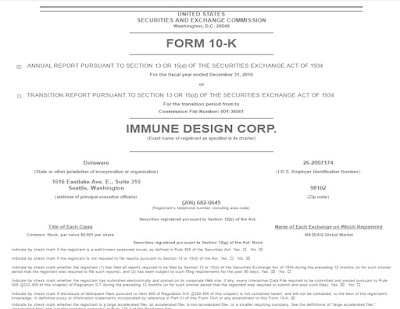少し時間が空いてしまいましたが、今回は「ワクチン リスト解説 第9弾」、アメリカ シアトルにある Immune Design という会社が研究・開発を進めている G103 というHSV2ワクチンをご紹介したいと思います。
(1)G103とGLASS Platform
まず、今回、参考にした論文というのが、以下のものでして、2016年に公開された研究結果のようです。著者一覧を見ると、ワクチン開発を進めている Immune Design からメインの研究者が3名、ワシントン大学およびその他の研究施設から数名でてきているようなので、中心的な研究は Immune Design が行っていることは確かであろうと思います。
G103は、以前紹介した HSV-2 Trivalent Vaccine と同じく、3つのタンパク質をターゲットとしたワクチン開発を進めているようでして、そのタンパク質というのが、グリコプロテインD(gD)と UL19 と UL25 というもので、いずれもウィルスが細胞内に入り込む時に重要な役割をしているようです。
このG103は、まだPre-clinical(治験前)の段階でして、まだ実際の被験者を使った治験は行われていません。そこで、いつもの「ギニーピッグ」さんを使った動物実験となるわけですが、その結果というのが以下のような感じになっているわけです…。
どうやら、HSV2を皮下注射したギニーピッグを2群に分けているようでして、それぞれの結果をA-B、C-Dというグラフで表しているようなんです。(ここに関しては何度も読んでみたのですが、その2群の分け方が何を基準にして分けているのか、イマイチ分かりませんでした…、スミマセン…)
ただ、要点としては…!
アジュバント(活性剤)のみを注射したGLAと比較すると、3種混合のワクチン(どうもGLAアジュバントも一緒に投与しているらしい…)の方が効果は高く、各週毎の再発頻度(AとC)およびその頻度の総計(BとD)のいずれにおいても、G103を投与した組の方が効果的に抑制できている
ことが分かります☆(^^♪
もうちょっと読み込めばわかるのでしょうが…、最終的には、
性器ヘルペスの再発を約50%抑えることができた
という 結果を得ているようですね。(^^)/
ちなみに、このGLAというものなんですが、少し調べてみると、以下のような説明が確認できました。
About GLAAS
Immune Design's GLAAS platform works in vivo and is based on a small synthetic molecule called GLA, or glucopyranosyl lipid adjuvant. GLA selectively binds to the TLR4 receptor and causes potent activation of dendritic cells (DCs) leading to the production of cytokines and chemokines that drive a Th1-type immune response. When GLA is accompanied by an antigen and injected into a patient, the combination is taken up by DCs and leads to the production and expansion of immune cells called CD4 T helper lymphocytes with a Th1 phenotype. These CD4 T cells play a key role in boosting pre-existing CTLs that are specific to the same antigen, neutralize a Th2 phenotype; and provide help to other immune cells and natural killer cells that are also important in the overall immune response. GLA can also be used to induce local and systemic immune responses against cancer by directly injecting it into tumors, where it induces a pro-inflammatory state of the tumor microenvironment. Immune Design believes that GLAAS product candidates have the potential to target multiple types of cancer, as well as infectious, allergic and autoimmune diseases. GLAAS-based product candidates have now been evaluated in over 1400 subjects in Phase 1 and Phase 2 trials demonstrating an acceptable safety profile.
http://ir.immunedesign.com/releasedetail.cfm?releaseid=958900
どうやら、GLAというのは「 グルコピラノシル脂質アジュバントと呼ばれる小さな合成分子」のようで、これがTLR4という受容体に結び付くと、CD4などの免疫細胞を強力に活性化させるようなんですね。このGLAを用いたアジュバントシリーズに「GLASS Platform」という名前を付けて商品化しているものと思われます。おそらく、基本的なアジュバントの作成方法は一緒で、各々のワクチンによって多少変化を加えていると思われますが…、詳しいことは分かりません…( ;∀;)
(2)ということで、開発の現状と展望は?
ということで、現状と展望なんですが…、残念なことに、
ちょっとかなり暗そうな感じ… (;・∀・)
なんです。
まず、現状の方から見てみましょう。
各企業には有価証券なるものがあると思うんですが、もちろん Immune Design にもあるわけでして、2017年4月には 以下のような Form 10-K(有価証券報告書)を公開してるんです。
そこで、ちょっと中身をのぞいてみると…、以下のような記述を見つけたんです…!
In October 2014, we entered into a collaboration with Sanofi Pasteur for the development of a Herpes Simplex Virus, or HSV, immune therapy. Sanofi Pasteur and Immune Design will each contribute product candidates to the collaboration: Sanofi Pasteur will contribute HSV-529, a clinical-stage replication-defective HSV vaccine product candidate, and Immune Design will contribute G103, our preclinical trivalent vaccine product candidate. The collaboration will explore the potential of various combinations of agents, including leveraging Immune Design’s GLAAS platform, with the goal to select the best potential immune therapy for patients. Each company will develop the products jointly through Phase 2 clinical trials, at which point Sanofi Pasteur intends to continue development of the most promising candidate and be responsible for commercialization. Sanofi Pasteur will bear the costs of all preclinical and clinical development, with Immune Design providing a specific formulation of GLA from the GLAAS platform at its cost through Phase 2 studies. Immune Design will be eligible to receive future milestone and royalty payments on any licensed product developed from the collaboration. For the years ended December 31, 2016, 2015 and 2014, we recognized $4.6 million, $4.2 million and $1.1 million, respectively, in collaborative revenue associated with payments received by Sanofi for development costs incurred to date for our development of G103.
Sanofi製薬(世界大手製薬会社ですね!)と2014年に単純ヘルペスに対する免疫療法を共同で開発することに合意した。Sanofiの方はHSV529を、Immune Designの方はG103を提供するが、それに加えて、Immune Designが持つ GLASSプラットフォーム(活性剤開発方法)を基に、免疫反応を引き出すのに最も適切な組み合わせを見つけることに注力する。
といった内容が記載されているようです…。
Form‐10K の別の箇所には、各新規薬剤に対する開発費用が記載されておりまして、G103に関しては、
2016年 4,432,000 USD(約4.5億円)
2015年 3,911,000 USD(約4.2億円)
2014年 999,000 USD(約1.2億円)
といった感じで「予算増額!」という、実に喜ばしいことになっていたわけなんです…。
ですが、ちょっと気になりませんか?
たしかに、HSV529もG103も(種類は違いますが…)同じグリコプロテインを対象としたDNAワクチンですし、共同開発をするには結構イイ パートナーかと思いますが…、
再発率を50%に抑えるワクチンと手を組むメリットがあるのだろうか…
と疑問に思ってしまったわけです…。
そこで、最新のImmune Designが2017年5月に行った投資家向け企業説明会の資料(ここから入手可能)を見てみると…、
となっており、
G103が書いてない! ( ゚Д゚)
んですね…!
この資料「Pipeline, News Flow, and Financial Highlights」には、開発中の薬剤名なども記載してあるわけですが、その中にG103が記載されていないということは…、Sanofiとの提携は、結果的には「G103の研究で用いたGLASS Platformを狙ったもの」だったということになるんでしょうかね…。
別の見方をすれば…、
G103を使った実験で、GLASS Platform がHSVを対象としたグリコプロテインワクチンにも使えることはある程度証明できた。それなら、GLASS Platform をHSV529に応用する方向で進んでいった方が良いのでは?
ということになったのかもしれません…。
まさしく、今日のタイトルを「GLASSのG103」とした理由がここにあるわけです(^^♪
ちなみに、先に示した Form 10-Kにも Pipeline に関する情報が記載されていたのですが、それを見ると…、
となっていて、G103はどこにも見当たらないんですね…!
「う~ん」、ちょっと(というか、かなり…)雲行きが怪しいですね…
少しでも多くのワクチン開発が先に進んで欲しいと思っているので、是非、結果を残して頑張ってもらいたいものです…。
というわけで、このG103に関しては、HSK529と併せて今後の動きに少し注目してみたいと思います…。






0 件のコメント:
コメントを投稿